After the beautiful, terrible Texas snowpocalypse

You might have heard about a little snowstorm that happened in Texas last week. If you experienced it, you might still be reeling a little — or a lot, depending on whether you were one of the 4.5 million residents whose power and heat were cut off by the state to save the failing electric grid. Huge swaths of paying customers were sacrificed, leaving them to shiver in the cold and dark for days, in many cases leading to frozen and busted pipes (Texas houses are not well insulated against cold) and then to flooded interiors when the thaw finally came.

For 6 days straight, Austin’s high temperatures didn’t rise above freezing, and for several nights they dipped to the single digits — at its lowest, a jaw-dropping 5 F. Early on, before the deep cold arrived, ice coated and broke trees. Then nearly 6-1/2 inches of snow blanketed the city, the biggest snowfall since 1949. After that, more sleet fell, and icy roads and pavement became treacherous for a state without fleets of snowplows and residents without snow shovels.

Those whose power had been cut were told that the blackout would be temporary, part of a rolling system of outages shared across the city to preserve the power grid. But for 40% of Austin, the outages didn’t roll. The power suddenly went out, and it just didn’t come back on — for days. Those who’d prepared for the storm by stocking their refrigerators tried to keep food from spoiling in snow-stuffed coolers, and many were unable to cook unless they had gas stoves. Told the outages would be temporary, many people stayed put while the roads were passable, only to make a run for a hotel or a friend’s house (coronavirus be damned) after roads had iced up, as it became clear power would not be restored quickly.
Several days in, water treatment plants began suffering loss of pressure, and many neighborhoods had their water cut off by the city. Soon the entire city was advised to boil tap water before drinking it — all while many people had no means to boil water without electricity, assuming they had any water to boil. The boil-water notice was just lifted a couple of days ago.

We were lucky not to lose water pressure, and we have a gas stove and gas-log fireplace. But our power was cut early Monday morning and stayed off for 3 days. Temps in the house quickly dropped into the 40s, up to 52 F by the fireplace. I wore a wool coat plus two layers day and night. We have friends and neighbors who toughed it out in 30-something temps in their homes. As the outages dragged on, housebound neighbors rallied together, sharing buckets of water to enable toilet flushing, offering hot cups of coffee, and providing moral support.
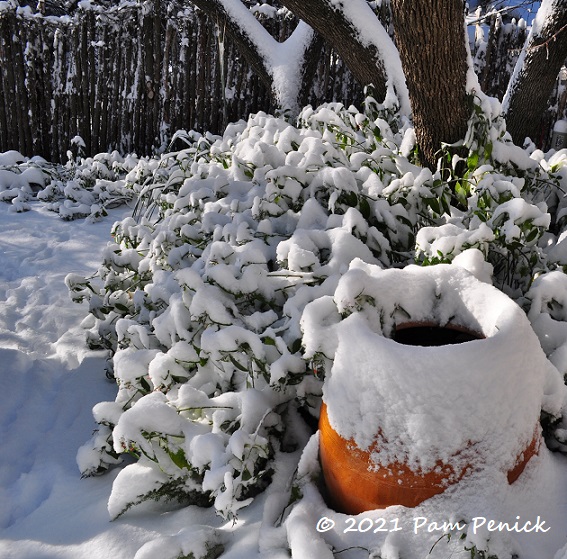
The snow and ice finally melted away last Friday and Saturday, and as our yards were revealed, plants looked surprisingly green at first. But over the past week, Austin’s normally evergreen flora have steadily turned caramel-colored. Succulents lie in mushy heaps like beached jellyfish. Gardeners all over Texas are wondering what will come back and what to write off as a loss. Only time will tell, and it’s going to require a lot of patience to let the plants show us the final verdict.
But pictures can tell the tale better than words…
Day 5 – Feb. 15: A winter wonderland

The Arctic’s unwelcome visit started on Thursday the 12th, with an icy rain that froze to tree branches. I saw a neighbor’s live oak crack under the weight and fall through their fence that day. On Friday a huge limb broke off one of our live oaks, thankfully landing on grass next door. Saturday and Sunday were just cold.
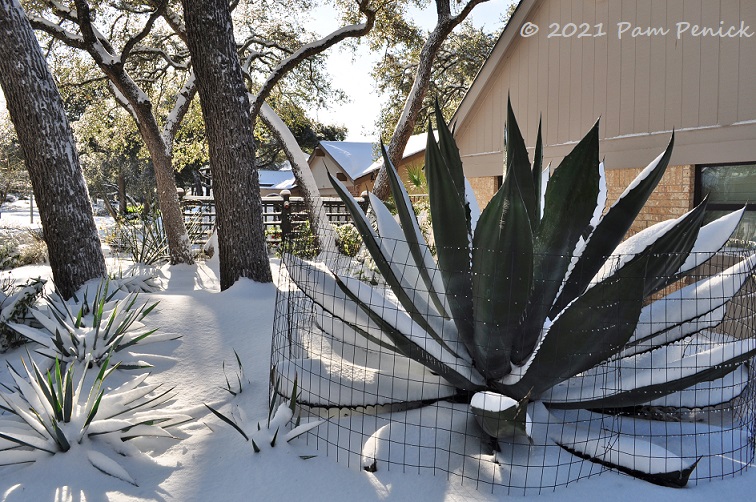
And then it got really cold — down to 10 F — as 6 inches of snow fell overnight. We went to bed in a rapidly chilling house, with power cut at 2 am Monday, and woke to a sight many Austinites had never seen before: snow blanketing everything, and not melting away as the sun rose.

It was wondrous, like Christmas carol imagery brought to life in a Southern climate.

Still, the cold was surprising. 10 degrees! I tromped around in sneakers, without gloves, taking pictures until my hands hurt from the cold.
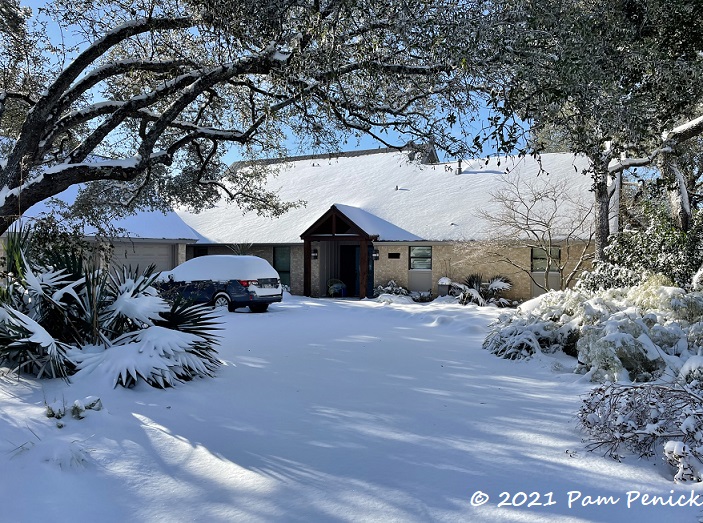
Untouched snow on the driveway. How our kids would have loved this as children!

Bamboo muhly, silver Mediterranean fan palm, rosemary, Jerusalem sage, and ‘Old Mexico’ prickly pear weighed down by snow. All of these plants would take a big hit from the deep freeze.

Whale’s tongue agave’s broad leaves cupping scoops of snow

Venturing into the back garden, I marveled over frosted stucco walls and live oaks.

Squid agave’s tentacled arms were frosted white.

No sitting today

The pool crisply outlined with snow — a pretty picture

‘Tiny Fern’ bamboo bent over with cotton balls of snow
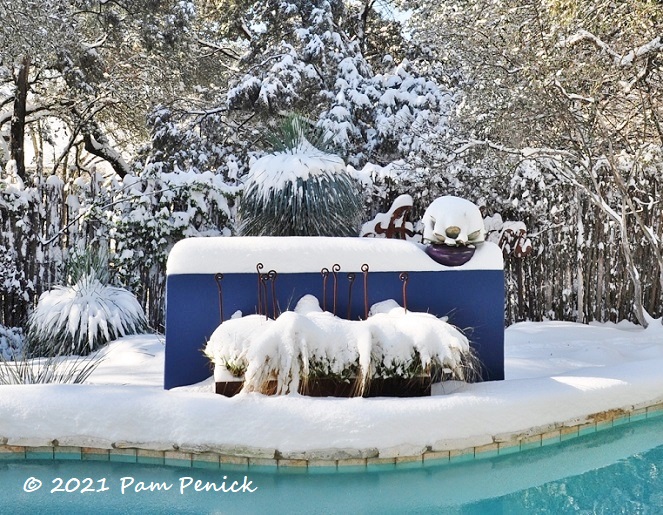
The blue wall, snow-capped. The bulbine in the low planter and artichoke agave on top would be killed by the deep freeze.

Cosmo shouldering his way through the snow. He’s a winter-loving dog. We often had to beg him to come back inside.

Fluffy Adirondacks

Looking back across the pool
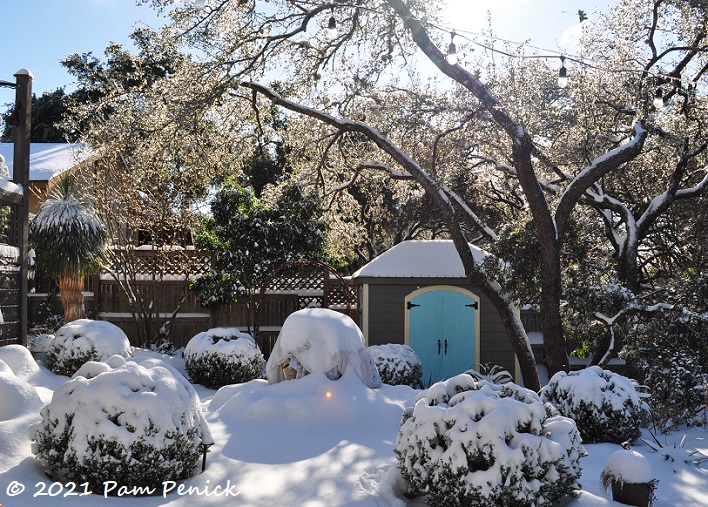
The ‘Winter Gem’ boxwoods splayed out under snow and sleet later, and I went out with a broom to knock it off. True to their name, they’ve held up extremely well. In the center, a potted whale’s tongue agave survived under a couple of sheets I threw on as last-minute protection.
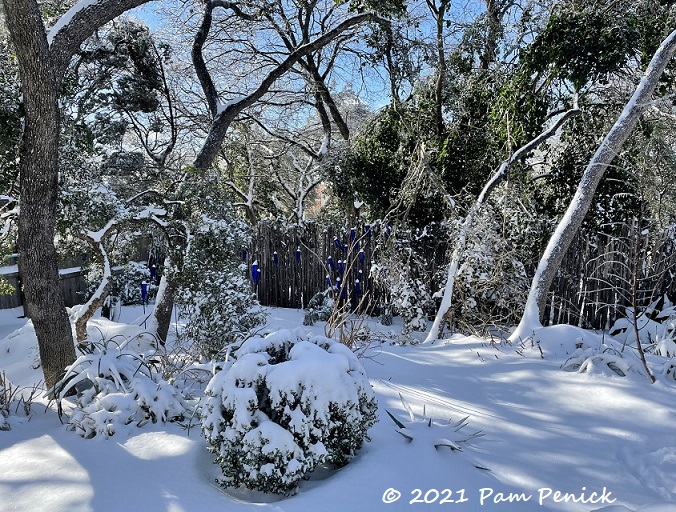
In the center-right you can see two large broken branches hanging from the tree-sized ligustrums in the greenbelt behind our fence.

‘Winter Gem’ boxwood and paleleaf yucca (Y. pallida), another survivor.

Blue bottle trees wearing little white caps

The lumps in front of the steel agave are potted ‘Color Guard’ yuccas. I threw sheets over this whole bed because of all the baby plants in it, and it helped.

Yucca rostrata drooped alarmingly with ice and snow, but it sprang back to life after the melt. Same with the ‘Blue Ice’ Arizona cypress behind it.
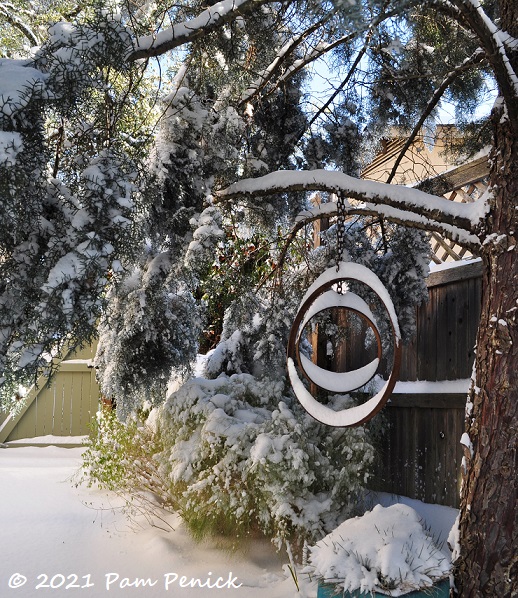
Snow-laden branches of Arizona cypress
Day 8 – Feb. 18: Icy and dangerous
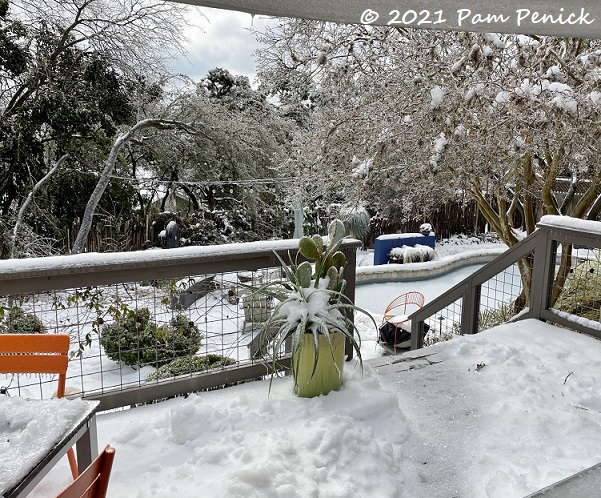
The winter-wonderland phase was short-lived, with no warm, cozy house to come inside to. And after more sleet turned the snow treacherously slippery, I avoided all the stairs in our hilly backyard and pretty much just parked myself in front of the fireplace except to cook a hot dinner each night on the gas cooktop. Spaghetti, grilled cheese sandwiches, and hot chocolate were our comfort foods.
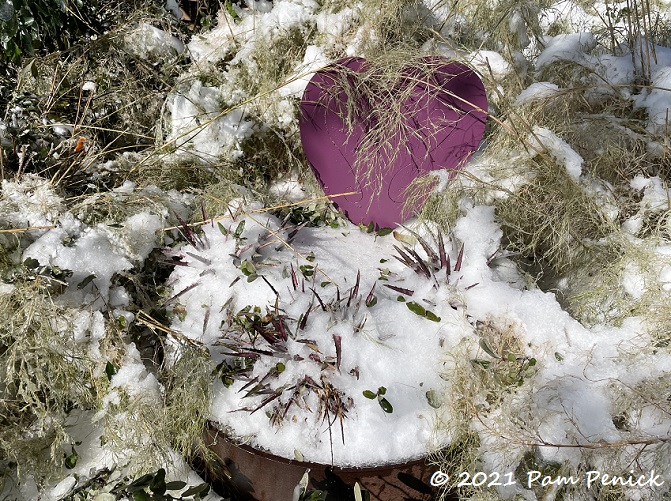
I took few photos during the endurance phase.

This photo pretty much sums up my mood by midweek last week.
Day 9 – Feb. 19: Melting begins

Finally by Friday temps climbed into the low 40s, and the melt began. ‘Green Goblet’ agave was already starting to droop.

The pool surface was still frozen.

And we had only a narrow path scraped clear on the deck.

The garden began to emerge, and it wasn’t looking pretty, though plants were still green.

‘Old Mexico’ prickly pear fruit “bleeding out” across the snow

Sad rosemary and silver Mediterranean fan palm

In the shade, ice hung on for a couple more days.
Day 10 – Feb. 20: Evaluating damage and survivors

So what lived and what died? I’ve been getting a lot of questions about the prospects for various plants, and I have them too. I just don’t have experience gardening in such prolonged low temperatures. Our plants are heat and drought survivors. They have to take a month or more of 100-degree days in stride. 5 degrees too? That’s asking a lot of these poor plants.

Native plants, of course, have the best shot at surviving winter extremes, although this was not a typical extreme, oxymoronic as that sounds. I’ve written a post about how to prepare a garden for a deep freeze in central Texas — and a lot of that just doesn’t apply during a once-in-a-generation event like this.

Longtime gardening experts in Texas like Greg Grant and Neil Sperry advise patience, leaving browned shrubs and trees alone for a few months to see if new growth appears, either on the stems or from the roots. If not, then remove them. Squishy foliage on succulents like agaves and giant leopard plant should be removed. Leopard plant will come back from the roots, I think. Agaves that are droopy and soft are toast. Leave somewhat tender plants like golden thryallis, Mexican honeysuckle, and esperanza alone until after our average last freeze date (March 1) as protection in case we get cold again.
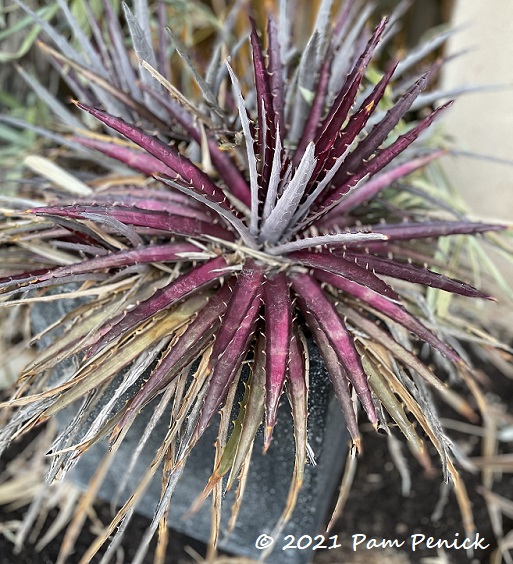
5 days post-freeze – Feb. 24: How much green is left?

Now that we’re nearly a week post-melt, how do things look in Austin gardens, and in my garden in particular? It’s a mixed bag. I’d say caramel is a dominant color all over town. But some pockets of my garden held up well, like the dry garden by the front door. Even containerized and unprotected, ‘Frazzle Dazzle’ dyckia, whale’s tongue agave, toothless sotol, and red yucca look good. The dwarf myrtle is browning a bit, but I think it’ll make it.
Update 4/1: The dwarf myrtle died back to the roots, maybe altogether. The dyckia is half-dead. The toothless sotol is significantly browned, and I’m still waiting to see if it’ll survive. The red yucca has some die-back, although it’s already sending up bloom spikes. Only the whale’s tongue agave survived unscathed.
Follow-up 12/1: The dwarf myrtle roared back from the roots and looks as good as ever. The toothless sotol rotted and died by late spring. The red yucca recovered swiftly. And half the dyckia died, but the front portion survived.

Hooray for sedges! ‘Sparkler’ sedge, ‘Everillo’ sedge, Berkeley sedge, and Leavenworth’s sedge (aka lawn sedge from Barton Springs Nursery) did very well, most emerging completely unfazed. I have a lot of containerized ‘Sparkler’ sedge, and some stems are getting a little straw-like, but most will live, I hope. ‘Soft Caress’ mahonia, in back, completely burned. I don’t know if it will live.
Update 4/1: ‘Sparkler’ sedge slowly browned over the following weeks and ultimately died back to the roots, but it’s coming back. ‘Everillo’ sedge sustained some freeze-damaged tips but is otherwise fine. And Berkeley and Leavenworth’s sedge are completely fine. ‘Soft Caress’ mahonia continued to decline and died to the roots, perhaps altogether.
Follow-up 12/1: Many ‘Soft Caress’ mahonias returned from the roots, but a couple died. The survivors are still small but recovering.
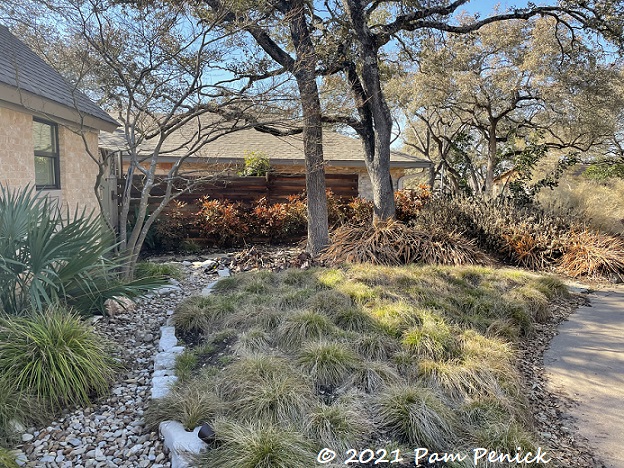
Lawn sedge (Carex leavenworthii) with ‘Everillo’ sedge at left — nice and green. There’s a whole lotta brown in the background though.

Not surprisingly, semi-tender plants like variegated flax lily, Mexican honeysuckle, bamboo muhly, and (who knew?) Chinese mahonia look like a fire swept through.

I hope Chinese mahonia will re-leaf, but it may take time.
Update 4/1: Chinese mahonia continued to turn brown, and I’m still waiting to see if it will come back from the roots.
Follow-up 12/1: I cut the browned mahonias nearly to the ground, and it took all summer and fall, but they finally put on new growth. They’re about one-third of their pre-freeze size but look healthy.

Giant leopard plant (Farfugium japonicum ‘Gigantea’) is hardy to zone 7, so I hope it will come back from the roots. I need to cut off the mushy leaves.
Update 4/1: Giant leopard plant quickly returned from the roots and looks great.

Native dwarf palmetto (Sabal minor) looks as good as before the freeze, which is a relief because it’s so slow-growing.

Native prickly pear (Opuntia cacanapa ‘Ellisiana’) collapsed, but I feel certain it’ll regrow from the roots. Texas sotol (Dasylirion texana) was completely unfazed. Golden thryallis is brown, and I’m just going to wait and see.
Update 4/1: No sign of life on the prickly pear yet. Golden thryallis is coming back from the roots.
Follow-up 12/1: The prickly pear has struggled, with deer eating new pads as they appear. But the golden thryallis recovered swiftly and grew as big as ever by the end of summer.

This is my saddest bed, and all my passing neighbors feel sorry for me when they see it. I’d just posted about this area, how pleased I was with it after 11 years of slow growth through heat, drought, and deer. The hubris! Mother Nature promptly knocked it down.
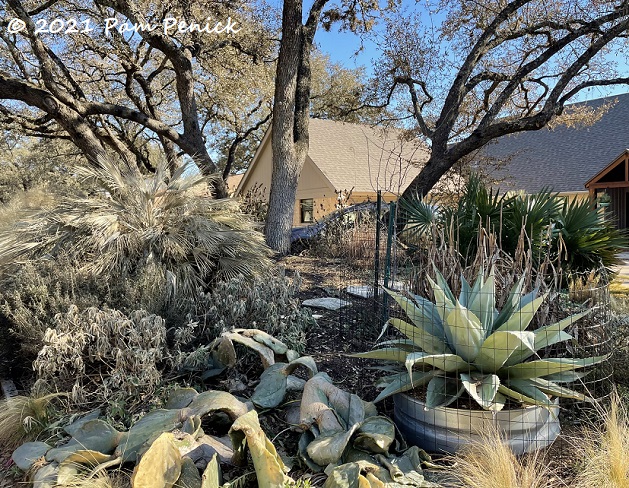
The whale’s tongue agave looks good still. Otherwise, all may be lost, although of course I’ll give it time to surprise me.
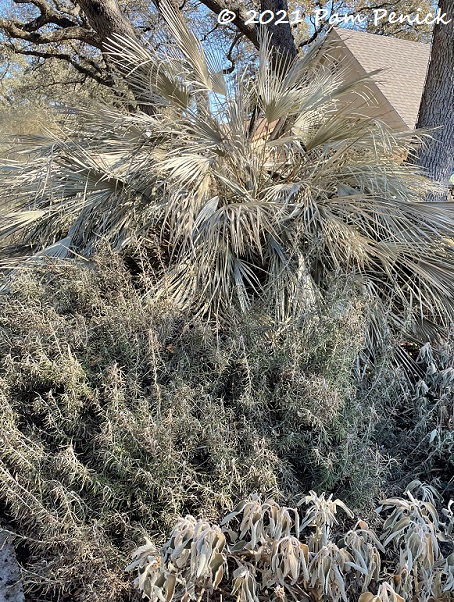
Ghost plants: My prized and very slow-growing silver Mediterranean fan palm, rosemary, and Jerusalem sage.
Update 4/1: The rosemary died. Jerusalem sage is coming back from the roots. The jury is still out on the fan palm.
Follow-up 12/1: The palm releafed and is nearly back to full size!

Beneath bleached bamboo muhly (I hope it may live), spaghetti-like leaves of Lindheimer nolina look good as new.
Update 4/1: Bamboo muhly is coming back from the roots.

The main part of the front garden looks fairly green thanks to the sedge lawn, although I think the ‘Margaritaville’ yuccas in it are squishy and dead. In the foreground, Texas nolina, paleleaf yucca, and lamb’s ear are fine.
Update 4/1: ‘Margaritaville’ yuccas are coming back from the roots.

This side isn’t so different from a “normal” deep freeze.
Update 4/1: The blue nolina in the center died.

But it’s a shock to see autumn sage all brown.
Update 4/1: Autumn sage is coming back from the roots.

Wide-leaf giant hesperaloe (Hesperaloe funifera ssp. chiangii) — no problems
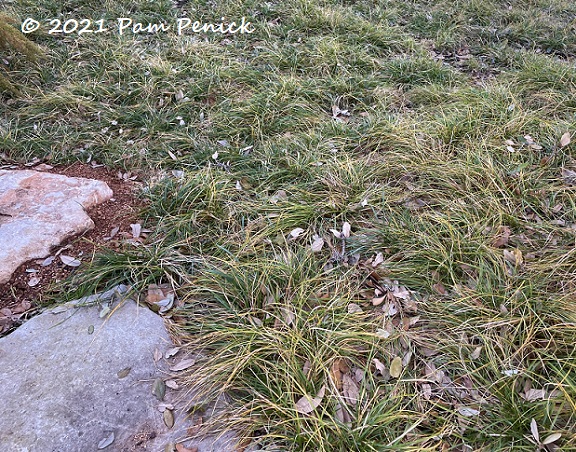
Good old sedge

Another big Mediterranean fan palm, bleached and sad. Tony Avent at Plant Delights Nursery suggests it may resprout. Does that mean from the base, I wonder, or along the trunk?
Update 4/1: I cut it back to the trunk, leaving only the leaves in the center crown. There are small signs of green on the trunk, so I’m watching and waiting.
Follow-up 12/1: The palm lived and fully releafed! It hasn’t yet attained its former breadth, but I think it will by next summer.

Giving a big middle finger to the universe. ‘Green Goblet’ agave, you who are about to die, I salute you!

Of all my whale’s tongue agaves, this in-ground one looks the worst, with major freeze damage. I’ll probably end up removing it, as the leaves will not recover. I also lost containerized ‘Quadricolor’ and artichoke agaves and some squid agaves.

Badness: Foxtail fern, firecracker fern, and an iffy squid agave in the tall pot. The ‘Monterrey Frost’ squid agave in the foreground, underplanted with ‘Blue Spruce’ sedum, may survive.
Update 4/1: The foxtail ferns and firecracker fern are coming back from the roots. The ‘Monterrey Frost’ squid agave lost most of its lower leaves, but the center survived, so I think it will live.
Follow-up 12/1: The ‘Monterrey Frost’ squid agave collapsed and died with a rotted center by early summer.

‘Alphonse Karr’ bamboo, looking more bleached by the day. The ‘Bright Edge’ yuccas in front are winners.
Update 4/1: The bamboo died to the roots, and I’ve decided to remove it altogether.
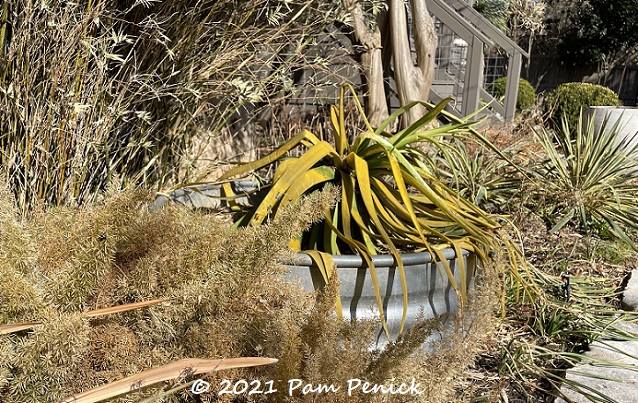
A big squid agave doing a Dali’s clock impression

The persistence of memory

I threw a sheet over this new bed, including the variegated whale’s tongue agave, and it looks OK. The agave survived, even in a pot. And the tender foxtail ferns got burned but lived. Small victories!
How’s your garden looking, my fellow Texans? Feel free to mourn your losses if you want. We all need time to grieve before moving on. Sympathetic readers from afar, yes, yes, it’s an opportunity and all that, we know, but it’s also a financial loss and a sense of lost time. We’ll be ready to start planting again soon enough. And to all who sent notes of concern and well wishes, thank you! They were much appreciated.
Update 9/21: Here are posts documenting the effects of the big freeze on all my plants:
- Still cleaning up after the freeze but making progress, March 2021
- My trees: Alive, dead or in-between? Evaluating plants 2 months after Texas freeze, April 2021
- My shrubs and woody perennials: Alive, dead or in-between? Evaluating plants 2 months after Texas freeze, April 2021
- My perennials: Alive, dead or in-between? Evaluating plants 2 months after Texas freeze, April 2021
- My agaves and other woody lilies: Alive, dead or in-between? Evaluating plants 2 months after Texas freeze, April 2021
- My succulents, vines, and groundcovers: Alive, dead or in-between? Evaluating plants 2 months after Texas freeze, April 2021
__________________________
Digging Deeper
Come learn about gardening and design at Garden Spark! I organize in-person talks by inspiring designers, landscape architects, authors, and gardeners a few times a year in Austin. These are limited-attendance events that sell out quickly, so join the Garden Spark email list to be notified in advance; simply click this link and ask to be added. Season 8 kicks off in fall 2024. Stay tuned for more info!
All material © 2025 by Pam Penick for Digging. Unauthorized reproduction prohibited.


It is so very sad to see all this destruction. I feel your pain but hear hope in your post. (I think I do). On a positive note, the snowy pool picture will make a great Christmas card for next year. I hope that amid the destruction you find new opportunities. There really is no other way and we gardeners are always at the mercy of a higher authority. If I could, I would come to visit with pruners in hand and a strong back to help you discard the debris. The compost pile will be huge.
I laughed out loud at the Christmas card suggestion, Layanee. I love how you always find the silver lining! 😉 Right you are! It WAS very beautiful that day, and a rare sight for us to enjoy.
You have much more loss than I do because your gardens ae so much bigger than mine. I’m just waiting to see what will come back, as we all are. I am concerned about the live oaks. All the leaves of the live oaks in my whole area (close to Driftwood) are brown. Surely the live oaks won’t die! What do you think?
No, they will be fine, Deborah. They would be losing their leaves anyway in a few week as new ones leaf out. Soon I expect we will have green live oaks again.
Pam, I am so grateful for this comprehensive and thoughtful write-up. It is cathartic and therapeutic. Truly, we are in mourning – for everything. Plants, people, animals, plumbing. The infrastructure we thought we had. Your post bolsters what little patience I am attempting to muster. The patience I have no choice but to muster, especially with the shock of 83 degrees we had yesterday, further stress-testing our ailing plants. To think that March starts on Monday!
I had just redone my elderly next-door neighbor’s yard 5 months ago, spending a month tearing out a literal house-blocking forest of rampant invasive ligustrum and asian jasmine. (2 tons of roots alone, according to the city dump’s scale). Patience and money are hard to ask someone for in those later years. It was just starting to take of in what had been a warm winter.
I am so sorry to read you were without power for 3 days! Here in deep South Austin, we had power out ‘only’ 12 hours but no water whatsoever for 5 days. I still have snow water in tubs. We spent 3 days melting it. My plumber’s-wife neighbor said, “Now I understand why my husband hoards water.”
I appreciate your (and everyone’s) collective sharing of what worked and what didn’t. To think of all the Soft Caress mahonia that can sail through 12 degrees and I never have covered any other time. And that some of us will have to replace lantana! In Central Texas! I believe it hit just the limit for some of them. Strongly appreciating my y. pallida, y. rostrata, sabal minor, sparkler sedges, Arizona cypress, Viburnum-leaf mistflower. And dollies, fish emulsion, and a husband who will help me move plants into the garage and subsequently into the house when the garage then became too cold. This is like a Twilight Zone inverse of the summer of 2011.
Thank you, again, and thank you to all our gardening community who are sharing.
Thanks for sharing your experience too, Kate. You’re right — it WAS the Twilight Zone version of the summer of 2011. Well, we got through that, and we’ll get through this too. But yeah, it’s been rough to see so much of our hard work and our plants’ beauty get frozen away.
Pam, these details have answered so many questions, so thanks for the info on how you and your neighbors managed to pull through. But what a terrible, terrible ordeal. I know I’m furious at a distance, so I can’t even imagine how betrayed you feel by those in power (literally/figuratively!) At least Cosmo looks to be enjoying himself! I can send agave pups just to fill some pots for summer, because they’re all tender, but let me know. I hope it’s a comfort to know that the vision you had for your garden was effectively realized, your knowledge and design skills brought it into being, and it was spectacular! It’s a huge setback, as you say, as far as the investment of time especially. I’m grieving with you, this just really sucks…
I was pretty incensed by the 2nd day of no power, but fury keeps you warm — ha! You’re kind to offer agave pups — thank you. But even before the deep freeze I’d vowed to myself not to add any more tender plants to my collection. It’s just too much work to bring them inside every time a freeze comes along. I am grateful to have that collection, however. My potted plants are adding welcome greenery to the garden right now, since I was able to shelter them in the house during the storm.
Our backyard here in Brenham is a total loss and will need a complete redo. Not even sure the small area of St. Augustine we have will recover. ERCOT reported yesterday that Texas was 4 minutes and 37 seconds away from a blackout that could have lasted for months. Five board members of this utility grid operator resigned. Let’s hope some changes are made because it’s likely we’ll be in the same situation come 100+ degree days during the summer.
I too would like to see accountability and fixes before the next cold snap or heat wave comes along. I’m sorry about your backyard. Please do give your plants some time before giving up on them though. Of course I don’t know what you’re growing, but I do expect the tough natives and some others to come back from the roots or re-leaf after several weeks of warm weather. Just let everything sit for now, although you can go ahead and prune away any mushy leaves. But save other pruning until after the last freeze date, just in case we get another cold snap.
Our experience was much the same as yours; long stretches with no power; and rolling blackouts the other times. We warmed food on a Coleman camp stove and were glad we had battery operated lanterns.
Plant experiences are about the same except my many squid agaves came through unscathed, even those out in the open in pots. Our low of ‘only’ 9 degrees in San Antonio must have helped in that regard, or maybe some cultivars collected at various places perform differently. You are welcome to some of mine to try.
I covered the five mature Golden barrel cactus with 3 layers of sheets and the appear to be unscathed. Many other things covered and uncovered (I even used our good sheets and blankets when I ran short of things to cover with) did not fare as well. Lots of plants in the greenhouse died because there was no power to operate the electric heater.
I am really heartened to see sprigs of Floratam St. Augustine popping up. The snow helped it survive for sure. Bark is still showing green on the two mature Arroya sweetwood trees, but not sure yet if they will recover completely.
It will be a lot of work cleaning up, but I’m not grieving. We just keep doing the best we can with whatever life presents.
That’s all we can do, it’s true. I’m pleased to hear about your squid agaves. I’m sure the few extra degrees helped. And it’s good to know three sheets were able to save your golden barrels too. So much depends on microclimates, and you gave them that “extra” that made the difference.
We followed this across the pond and stunned with what happened, weather and power outages for days. To see your beloved plants in such a state is not easy. Roll on spring and hopefully by summer all that’s happened recently is just a distant memory.
Thanks for the good wishes, Mark and Gaz!
Thank you, Pam, for this post and photos of your beautiful garden during and after this horrific event last week. I have the same feelings about my 20 year old Austin garden that has literally given me my life here as a native Southern Californian who loves to be outside creating beautiful spaces and caring for them. This week I also read your post and commented about you visiting James David’s garden as a farewell tribute when he moved to Santa Fe. That post helped me to finally understand what it means to lose things and having to take a devastating event and turn it into newfound wisdom and new adventures. We can grieve for time and financial loss but we must then look to the future and what we want it to look like. James David was quoted saying in an article from Metropolitan Home magazine in 1992, “a true gardener knows that gardens are about change. You can’t keep them static”. Duly noted and after I grieve, I will move forward………
James is a wise gardener. Thanks for sharing that, Elizabeth. Austin gardeners are in the mourning stage now, but soon we will all be looking forward. It’s what we do.
Thank you for the detailed and photo heavy post. I braced myself as I started reading, knowing it was going to be bad. I pray the things that are looking like they’ve made it only get better and better as time goes by. I can’t imagine removing those squishy agaves, what a job… both from a heartbreak standpoint and the mess and stench.
And they’re so big! That ‘Green Goblet’ was almost as tall as I am. Needless to say, I will be hiring help to tackle that mushy monster.
Your garden looked truly stunning in the snow. Your planting and pool made for a beautiful scene. I ‘m sorry for your losses but maybe much will survive. It is hard to lose big structural plants. I think your large trees may have saved many of your plants. I am wondering now what zone I am in. I never think I am in zone 8, more like 7, so maybe for me it was a zone 6 event. Or was it? I lived in Canada and remember days when you couldn’t go outside for the sun zero temperatures but everything was covered with a blanket of snow and plants protected by such. The ice coming first was a bit of a killer.
Yes, the ice coming first was unlucky. If only it had been snow alone. Ah well, it’s over now. And let’s hope we don’t see anything like that again for another 30 or 40 years.
Pam, my heart truly breaks for you and all of Texas. Not only the garden losses but the human toll – what a tragedy. So sorry. You are right, it’s a loss of valuable resources, the most important – time – cannot be reclaimed and gosh, that stings. A once in a century kind of weather event like this takes even the native plants by surprise. I pray roots of many of these plants pump it up into high gear this spring and surprise you with new growth.
Thank you, Tamara. I’m hoping for that too. Plants want to live!
I am in zone 8a/8b, in midlands of South Carolina, so some of the plants you view are not suited for my area.
We missed the snow, only got rain, so think you for the show.
I also got the Ox Blood lily/School House lily that Texas is famous for.
I hope it gives you a good show this fall! It’s such a happy sight to see it blooming in late summer-early fall. P.S. I grew up in Greenwood, S.C.
Beautiful and terrifying photos. I don’t even know what to say, and I imagine how you must feel. You’ve been in my thoughts a lot.
The carex surprised me more than anything. I’d always assumed it was more tender.
Hoping you’ll find positive surprises in the weeks to come…
Most of my carexes still look good. But ‘Sparkler’ sedge has dried out a bit more since I posted this. Some look worse than others, so I’ll just have to wait and see. It’s interesting how long it takes some plants to show the trauma.
How tragic. You are losing old friends. I grieve for you.
Thanks, Julie. It was a blow, but I’m coming to terms with it now and starting to look ahead.
Oh Pam, I was wondering how your garden and family fared with all of this crazy weather and power catastrophe. I am glad you are ok. The garden looks so disheartening. I can’t imagine how it must be to you. Wishing all the best that can be. Big hugs…
Thanks, Lisa. It was pretty bonkers, but it makes for a good story after! 🙂
What a nightmare, Pam – for both humans and plants, and probably wildlife too. I know how you – and many other Texas gardeners – feel about your plants and my heart breaks for you seeing all those mushy specimens. When I first heard of your arctic blast, I too thought it would be a short-term slap, painful but not debilitating. The intensity of the event in hindsight speaks to the warnings we’ve heard for some time now about extreme weather events becoming both more extreme and more common. While it may be too early to draw a conclusion, the renewed drought conditions here, with the lowest rain totals I’ve seen yet and little good news in sight, already has experts concerned about our next fire season, as if 10,000 fires covering 4.2 million acres in California last year wasn’t bad enough. At this point, gardening is beginning to feel like a vicious game of dodge ball.
True, Kris. And Californians know better than anybody about climate disaster events. I hope you get some good rains soon. That worries me for you.
P.S. You didn’t mention any of your beautiful pots. Here if I would leave pots such as yours out during winter they would bust apart. I hope you don’t have that problem on top of mushy plants.
I was able to bring in the majority of them, Lisa. There are big pots here and there that had to be left outdoors, and many of those plants died. But I’m happy to have saved the ones I could.
I cannot imagine how you must feel, losing so many beautiful plants you have cultivated (and loved) for years. This past year has been a freaky time, no doubt, and this winter debacle tipped the scales, it seems. Unlike your large number of plants and huge garden of gorgeous succulents, I have only a relatively tiny cottage garden, but I am grieving for our losses as well. My husband and I will celebrate our fifth wedding anniversary in July, and our garden is about four years old. This past year my talented husband built a low white picket fence around our garden and added two uniquely hand-made arbors. We had a very successful flower garden last year. The best yet! Our garden is a work of love. It has represented our hope in a new life together, and for the first time in our 60-plus years, a beautiful love story. One of my fondest dreams has been to successfully grow sweet peas (the flower, not the edible pea) along the lattice fence, and this fall (the correct time to sow them here in southeast Texas) we planted many lovely colors of climbing sweet peas. They were coming along beautifully, green and vibrant, and we were anticipating many fragrant blooms! We have covered them many nights this winter, even when we knew they would probably survive temps as low as 25 degrees. We thought we had a good system with a wind block on the north side and row cover over them which we anchored securely with stones. But our temp went down to 11 degrees, and it stayed well below 20 degrees several days and nights. The sweet peas looked dead and dry. I watered them anyway, thinking “what the heck!” Yesterday I noticed green leaves here and there, so I have a little hope a few may survive. Many other plants are history, however, things we have sheltered and pampered along in our highly mutable (and frustrating) climate. Yet our small cottage garden in the Big Thicket of Texas has a few survivors: baby hollyhocks, poppies (only three), roses (they look pretty bad, however). I don’t know if the thirty-five lantanas we put in last year will survive. They look dreary and dead. Does anyone know if lantanas will survive 11 degrees? Oh, they were beautiful last summer and fall, teeming with Gulf Fritillary butterflies! We tried to cover everything possible. Interestingly the nigella seedlings (planted in the fall) made it through the icy cold (under cover) and have not been affected in the least! The evergreen lemon thyme seems to have ignored the low temperatures completely, and the ‘phenomenal’ lavender appears to have survived. My little greenhouse harbors new plants we will put in this spring. There’s hope! Life is one long series of “starting overs,” as my husband and I have discovered in the separate paths of our life that miraculously converged in 2016, and gardening is a perfect symbol of that truism! Thanks for the breath-taking photographs and your wonderful blog. Take heart, dear gardener!
Thanks for sharing your experience, Debbie, and your hopeful signs of new life. That’s great to hear! Many plants will prove resilient in time, I hope. I’m not sure about the lantanas. Will you report back later to let us know? And by the way, congrats on your happy love story and upcoming 5th anniversary!
Holy crap…That is devastating. I am so sorry. Hoping your replacements are as beautiful as the ones that Climate Change took out. xoxo
Thanks, Gail. 🙂
I thought about you a number of times, Pam, as the freeze seemed never to end. I am so sorry about the loss of the whale tongue agave. I know they’re your favorite.
I feel like no one will believe me, but I have online proof that we dropped to -6 degrees F in east Texas on the morning of Feb. 16th.–That temp. aligns with zone 6. I’m supposed to be living in zone 8b. I will wait a full 6-8 weeks before I remove stuff to see if perhaps it comes back, but I think I lost a wax myrtle, a pomegranate tree I grew from a cutting, a rare sweet olive tree, Ellen Bosenquet crinums, agapanthus, butterfly vine, and a few roses. There are many, many more that are most likely dead. I also had huge live oak tree limbs fall. I am not going back in with zone 8 plants. From this point forward, i will only purchase plants that can take zone 6-9. It’s just too heartbreaking. I do hope your plant damage ends up being much less than you think.
Thanks, Laura. It’s hard to read about your plant losses. I know how discouraging that feels. My fingers are crossed that some of those will prove more resilient than expected.
I am used to dealing with power and water out – we have alternatives.
But NEVER with the ice and snow.
I hope that your plants will surprise you by sprouting again as the weather turns kinder.
With snow your garden looks strange, but rather beautiful!
It *was* pretty under that first layer of snow, Diana. Such a strange sight here!
Hard to know what to say as I love all your Texas landscapes. No matter where you live and garden, we are all starting to see the reality of climate change. And the reality is surprise after surprise. Impossible to determine what to replace and replant. Glad that at least you all came through it generally safe and sound.
Thanks, Linda. Yes, the changing climate is making gardening even more challenging, as old records on temperature, drought, floods, and the like continue to get broken. I never expected to see record lows in Texas, I confess.
OMG, Pam…I’m so sorry…I really didn’t expect the damage to be quite that bad 🙁
It’s pretty bad! I keep doing double-takes at all the brown foliage.
Pam, first, my complete sympathy for your lengthy power outage. And for your garden. As you probably know, all the broadleaf evergreens will defoliate. To assess a woody plant, simply scratch the bark with a knife or thumbnail. If the cambium underneath is green, that part is alive. The one thing I did for my palms that I could reach (some are too tall) is to pour a copper based fungicide down the newly emerging spear (leaf). Fungal rot of the meristem is often what kills a palm after an event like this. Good luck to both of us! Btw, did your pool lining suffer any cracks?
Thanks for the tip re: the palms, Peter. I hope yours will somehow pull through. The pool seems OK, although we haven’t inspected it carefully yet. David lowered the water level below the waterline tile to save it from getting cracked. And because we were on water restrictions we haven’t filled it back up yet.
I laughed in recognition when you said you survived on grilled cheese sandwiches, pasta, and hot chocolate. We did too, with a couple of pots of black beans besides. And we also lost power at 2:00 am on Monday and were in the dark for 72 hours. I detest the smell now of the scented candles that we lit those three evenings.
Lost two American agaves, two sago palms, and probably a dear calamondin orange I’ve had for over 20 years. But the sweet olive took the brunt of the wind and snow (while covered with a sheet) and came through with only a few frost-burned leaves. Who knew?
Are you using liquid seaweed to help the plants that have survived?
We had beans too! 🙂 Your comment about the scented candles made me laugh out loud. You’ll probably always have flashbacks when you smell those scents!
I’m sorry about your plant losses. In my garden, I had spread several inches of compost a few weeks before the deep freeze, so I’m just letting that feed the roots right now. I could be wrong, but I would hold off on liquid seaweed or any applications of fertilizers until we’re past the last freeze date. Stimulating early growth right now, while plants are still stressed, could be bad if we get another freeze, which could happen even into March. Everything I’m reading says to wait and do nothing right now except prune away mushy leaves.
The snowy pictures are so beautiful and yet the damage is so heartbreaking. I know someday soon we’ll be excited about buying plants to replace what we’ve lost, but I’m not there yet.
Me neither, Wendy. But yes, spring fever will get us again sooner or later. 🙂
Pam, I’m so accustomed to your green garden year round, that even though I love what to expect your photos still hurt. Those huge, sad palms! I’m surprised any of your Whales Tongue survived but I’m glad they did. And like you, I looked at my half dozen mahonias and thought what the heck? I’ve lost over a dozen pittosporums, 6 huge Aralias, and maybe ask the viburnums and loropetalums. Basically, the entire yard other than the loquat, yews and the maple trees. Welp, moving on, right?
That should read “even though I knew what to expect, the photos still hurt to see”
It’s so painful to see our plants like this. I’m sorry for your losses, Robin. Have you scratched the stems of the ‘Soft Caress’ mahonias? I haven’t yet, but today I scratched one of the Chinese mahonias and found green near the top, so I believe they will be OK. Hoping the others will too.
So sorry for your losses, but glad you were able to see some beauty in the freak weather. If you need a distraction there is a YouTube channel called Crime Pays but Botany Doesn’t, and he posted a video titled What Happens When Tropical Plants Freeze filmed in Hidalgo Co. Tx. If you are troubled by very colorful language, forget my suggestion.
Funny title! I’ll check it out, Les. Thanks for the humor. It’s laugh or cry!
Your gorgeous landscape suffering so much destruction. So sorry, Pam. Hopefully TX decides to, and implements actions to prevent a massive loss of electrical power during the next polar vortex storm. So much suffering, by everyone and everything.
Thanks, HB. Changes need to be made so this never happens again. We can’t do anything to stop Mother Nature, but we can at least decide it’s not OK to let people freeze in their homes.
You said it, sister!
“We can’t do anything to stop Mother Nature, but we can at least decide it’s not OK to let people freeze in their homes.”
My heart goes out to you, Pam. Seeing all of your photos brought what we saw on the nightly news here in NE down to a much more personal level. Those of us who love our gardens can only imagine how devastating it must be to lose so much in such a short span. I love how you are holding on to the hope that no matter how ragged some plants look at the moment they might still have enough life left in their roots to send up new growth. Keeping the faith along with you!
Thank you, Ellie. Everyone has been so kind, sending good wishes for recovery. It’s made it easier to bear!
Wow Wow Wow. I’m so sorry for all my Texas gardening friends. Your plants become your extended families. It’s legitimate grief.
It really is, Jen, though of course it doesn’t compare to the human toll this storm took. But we do love our plants and gardens. And we will have beautiful ones again. It’s just going to take some time.
I’m just glad that you all are OK after no heat, power, etc…that’s as scary as what went on outside for longer and later than ever. Thanks of course for all the plant performance recaps, and I’m sure you’ll have the final tally in the next couple months. Interesting how entire areas and plant bones did well in the cold, plus ice storm, snow, sleet, etc. I need to finally complete the same tally from my region’s Feb 2011 uber-freeze, either a 100 or 20-year / generational event. Not sure, “I’m a recovering LA, not a mathematician…Jim!”
Hah, yeah, it’s a lot of work to document what survives and doesn’t from events like these. Everyone here is swapping plant info as we all try to figure out what our toughest plants will turn out to be.
Jana and I were just talking about you today. “Wonder if Pam knows what will survive and what won’t? Hope she does a post!” Sorry for your losses…and mine.
Anne, I’m figuring it out like everyone else. There are some “old-timers” who’ve been gardening in Texas since the deep freezes back in the 80s, and who are sharing what-to-do info on Facebook; I’m sharing those posts on my public FB page. Check those out for lots of good advice. I’m sorry about your plants too!
I bet many of your more herbacious plants will come back from the base. The Phlomis is hardy in Denver and looks like that at the end of each winter. I bet your fan palms will resprout from the crowns.
I’m hearing that too — re: the Med fan palms — from experienced plantsmen and gardeners here. My fingers are crossed! Thanks for the info re: Phlomis too. It will be interesting to see how much innate hardiness comes into play with our plants that are acclimated to our warm climate, and which did not have a hardening-off period before the deep freeze arrived.
As always, thank you for the informative post. I’m grateful as well for your February 14 post which included educated guesses as to what plants probably wouldn’t survive the coming deep freeze. I live in Fredericksburg and I too lost many of the same plants you felt were at risk. You gave me time to mentally prepare.
You’re welcome, CecilSea. I’m glad it was helpful. Of course now we need to let our gardens just sit for a bit and see if new growth appears over coming weeks. It’s hard to let all that brown just be.
Oh, so sorry to see all that devastation. It’s heartbreaking to lose so many treasured plants. On the bright side, glad for your gas cooktop and fireplace! Hope this never happens to you all again.
Me too, Bev, and thanks for the sympathy. 🙂
Sorry to see the damage on some plants, specially the agave’s. On a positive note, your garden looked very beautiful with the snow. Some of the plants that survive on my garden: Elbow bush, evergreen sumac, hill country penstemon, blackfoot daisy and golden groundsel. I’m patiently waiting for the outcome of other plants but not sad, ready and excited about new plant possibilities. Thank you Pam!
Spring will lift all our spirits as plant survivors make themselves known. Happy to hear about your toughest survivors!
The world has watched in horror and fascination, so this post intrigued. I’m sorry at your losses, but I’m sure you’ll use it as an opportunity to rebuild in new ways, with new plants. Good luck!
Thank you, Robin.
Heartbroken here in our little freeway garden, but with each passing day, I become more determined to put on my big girl panties and go on. I’ve spent days and filled untold compost bags, but I’m starting to reimagine and replant. The alternative is impossible to this gardeners heart!
Thank you for making concrete our garden grief. Each day as I cut and dig and hack, I feel tender and sad—as if I’m preparing a body for burial. I think we need a wake. And a lot of wine.
I’m so sorry for your plant losses, Cynthia. It’s a process to work through it all, for real.
The fan palms should be okay, they will push new growth from the top. Just give them time, they are more hardy than you think. Maybe try a high phosphate fertilizer. The plants that survived are going to need a big boost of food. Sorry about your garden though.
Thanks, Tyler. I’ve heard that too, that the Med fan palms may recover if the center is still green. That’s the case with my standard Med fan, but the silver/blue Med fan is bleached all the way to the center. Does that mean it has no chance of coming back? Or should I wait until this summer for it too? I’ll give the fertilizer a try as well. Luckily I had spread several inches of compost a couple weeks before the freeze, and I’m hoping that that extra layer may have protected the roots of some of my more tender plants as well.
This post was epic. The hardest plant loss for me so far, have been the agaves. Our whales tongue agaves did not fair well at all. Also, the artichoke agaves. Also, the blue glow agaves despite being covered. I laughed so hard at the middle finger salute your Green Goblet gave the universe. Must be a species things because our GG is doing the same thing in solidarity. I thought lantana would survive a nuclear apocalypse along with scorpions & cockroaches — but I was wrong. Very wrong.
The pandemic has been hard, but yardening helped. The election and insurrection debacle! And then my mom fell right after Christmas and was placed into hospice. Adoption of adorable part stinker/part lovebug kitten from APA! — helps. And then the Big Terrible Freeze. It seems too much sometimes. But, then the sun comes out or when I’m out and about I hear four favorite songs in a row. I hear the birds still singing their spring songs. We can can do hard things like have patience and reimagine our gardens & yards. I like your words: plants want to live. Things will get better (I hope).
Sherry, you are right — it does seem like too much sometimes. As you point out, we’ve all been through some serious emotional lows over the past year. And I’m so very sorry about your mom. But eventually the sun does come out, and the birds still sing, as you eloquently put it. Hang in there. Hug that kitten if he/she’ll let you. 🙂 And when you’re ready, the garden survivors will be there waiting for you. I’ve just started doing a bit of clean-up, and it’s sad, but it also helps.
[…] the 3 weeks since the Big Freeze, there’s been much gnashing of teeth and grim side-eye given to the cold-toasted garden. […]
My whales tongue is sending up a bloom stalk. Guess after two nights of single digit temps – then last weeks golf ball size hail tearing it up it decided it was time to leave this cold cruel world.
If you still want to get rid of your damaged whales tongue I will dig it up for you if the center is still alive.
Interesting, James. I have a soap aloe that was seriously maimed by the freeze, and it’s sending up a bloom stalk too. Of course if it can recover it’ll be able to bloom many more times, unlike the agave.
My damaged whale’s tongue is already gone, but thanks for the offer.
I’m glad so much is returning for you; I would have never guessed that foxtail fern would return from the roots. I imagine you have a very strong emotional connection with many of your plants – I know I do with mine – and it sure is nice to still have them in our world. Thanks for sharing your update.
Maggie, the foxtail fern is a total surprise. I’ve seen it killed by lesser hard freezes. The only explanation I can think of is that the deep snow that week provided a blanket of insulation, allowing it to return quickly from the roots when it melted away.
Hey Pam, thanks for the recap of what lived and what didn’t, it will be a great record for reference next time we go through this. I’m in San Antonio so had similar plant experiences and am reading your recaps to track my own survivor story. I was anxious when in your early posts you said the Bamboo Muhly was a goner but, like yours, mine is coming back from the roots like gangbusters. Last fall I had pulled out a fence line of ancient pittosporums left by the previous owners and replaced them with Texas and U.S. natives (Texas Persimmon, four varieties of oakleaf hydrangeas, Mexican Plum, Forestiera pubescens, Eupatorim viburnoides, Amyris texana, and Beebrush). I worried they were too young to have survived but they all came back beautifully! I had one hydrangea I thought was a goner but at long last, it finally has buds on it. Even our Myers Lemon and Mexican Lime lived (but they had been covered with halogen lights under the sheet, which didn’t help much when we lost power for 12 hour stretches). Anyway, my message is, congrats on your survivors and please continue to watch and document, as it seems like they are stronger than we thought, just as we all are.
I’m happy to hear of your survivors too, Carmen. Good call in replacing the pittosporums with native shrubs and trees. That really paid off for you, I bet! I’ll do future updates as time reveals more lessons from the epic freeze.
[…] been two months since the Big Freeze of mid-February, and my garden, which thankfully has many thrivers, is still revealing struggling survivors and […]
[…] started to plant the new garden bed when the February deep freeze happened. The Mediterranean fan palm that shielded the space from the street died back to the […]